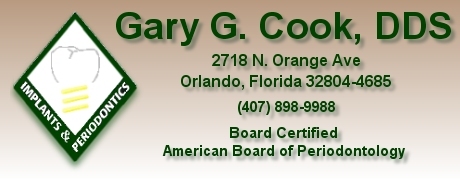


|
FACTS ABOUT DENTAL IMPLANTS DENTAL IMPLANTS:
Ask yourself the following questions: Are you missing one or more of your natural teeth? Do you have a complete or partial denture that is no longer comfortable? Have you ever been embarrassed by the appearance of your denture or bridge? If you answered "yes" to one or more of these questions, contact our office to schedule an evaluation appointment. We would be pleased to evaluate your oral health and discuss treatment options with you. |
|
Dental Implants: A State-Of-The-Art Alternative The purpose of titanium dental implants is to help restore your mouth to excellent dental health. In doing so, they can improve your quality of life by enhancing your appearance and self-confidence and the ability to eat your favorite foods. Implants support restorations that look like your own teeth and stimulate the bone in which they are placed to prevent the ongoing shrinkage of the jawbone, which often occurs when natural teeth are missing. In an otherwise healthy individual, the success rate of the implants placed using the Nobel Biocare Brånemark® and Steri-Oss® implant systems is 94 to 99% (75% in smokers). The first Nobel Biocare implants were placed in 1965 and are still functioning well today. At the present time, there is no limit on the life expectancy of successful Nobel Biocare implants. Implant restorations can be an alternative in many cases to bridges, which require the preparation of teeth adjacent to the missing tooth or to a removable partial denture. Implant placement requires an adequate quantity and quality of bone to be successful. For patients who do not have sufficient bone to support dental implants, bone augmentation procedures may be indicated to improve the quantity of bone. Patients who could not have enjoyed the benefits of implants in years past can now have successful dental implant treatment because of these procedures. Dr. Cook will determine whether you are a good candidate for this type of treatment. The placement and restoration of most dental implants occurs in three phases. These phases describe the process for replacement of a single tooth or a bridge that replaces several teeth. When implants are used for more complex cases, the process may vary. Phase I Phase II Phase III
The procedures described above are typical for many of the implants we place. Depending on a variety of factors, occasionally Phase I and part of II can be completed in a single appointment. Phase I and Phase II are surgical procedures. Local anesthesia ("Novocain") is used to numb the mouth so that the procedure can be done painlessly. Preoperative and postoperative directions will be given to you. If all directions are followed, you should expect minimal, if any, pain, bleeding or swelling postoperatively. Although the success rate of dental implants is extremely high, they cannot be guaranteed. In such cases, the implant may be lost. When an implant fails, it does not fuse to the bone and is no longer stable. In these cases, the implant must be removed. When this occurs, it normally happens within the first few months after placement, but it could happen at any time. Usually a second attempt can be made to place the implant successfully after a sufficient healing period. Though rare, complications can arise from implant placement. These complications include, but are not limited to, post surgical infection, bleeding, swelling, pain, bruising, and transient or possibly permanent numbness of the lip, teeth or chin. Alternatives to dental implant treatment include no treatment, restoration with fixed bridges (when possible), or removable dentures. Effective oral hygiene techniques are required everyday to maintain dental implant restorations, just as they are for natural teeth. Periodic examinations and radiographs to evaluate their status are likewise. We will be happy to answer any questions that you may have regarding dental implants. Our goal is to help you understand the benefits and procedures for implant restorations so that you can make an informed decision regarding this unique treatment opportunity.
|
Last update: 03/16/2023